If you ask any grower which part of the cannabis contains the most cannabinoids, they’ll say it’s the trichomes.
Cannabinoids aren’t produced in the flowers or leaves of cannabis. Instead, they are produced and stored in the tiny glandular hairs that you see on the surface of marijuana plants.
All types of trichomes and harvesting chart
Trichomes are also responsible for making terpenes, giving cannabis its distinct fragrance and flavor.
Similar to how chili peppers are spicy, cannabis flowers use their bitter taste and pungent aroma to deter most pests.
However, growers have trained cannabis to produce more palatable flavors and smells.
If you have extensive knowledge about trichomes, you can maximize the potency of their yields. Start by reviewing our trichome harvest chart.
The 3 types of trichomes on cannabis plants

Bulbous trichomes
This type of trichome appears on the surface of the entire plant and is evenly distributed throughout.
Out of the three types, bulbous trichomes are the smallest, with a width of only 10-15 microns. In comparison, a strand of hair has 40-50 microns. You’ll find very little THC in them.
Even though they don’t contain as many cannabinoids, bulbous trichomes are still beneficial for cannabis plants.
For one, they help protect plants from intense UV light along with the other two types of trichomes. Second, and most importantly, growers use bulbous trichomes as an early indicator for harvesting.
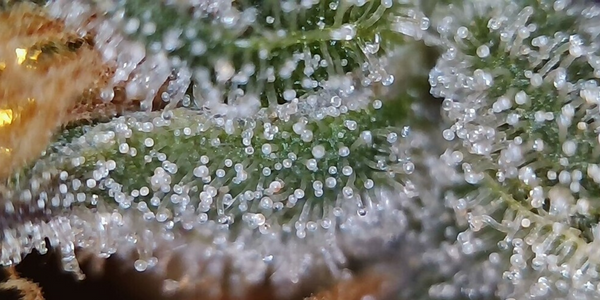
Capitate-stalked trichomes
Capitate-stalked trichomes are the largest type of trichome found in cannabis. It is also the most abundant among the three.
They have a size that can measure as much as 500 microns. During flowering, the density of this type of trichome increases.
When using a trichome harvest chart, it is important to look at capitate-stalked trichomes instead of the other two types.
This trichome type contains most of the THC and trichomes in your plants.
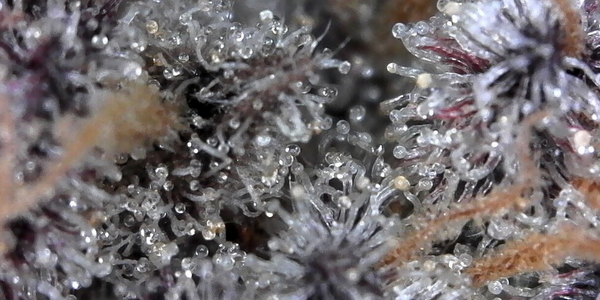
Capitate sessile
Capitate sessile trichomes are the second largest type of trichomes in cannabis.
While capitate-stalked trichomes are mostly found in flowers and rarely on any other parts, capitate sessile trichomes appear primarily on the underside of fan leaves and sugar leaves.
Because of this, many people use capitate sessile trichomes for cannabis products such as concentrates or other edibles.
The different stages of trichome development
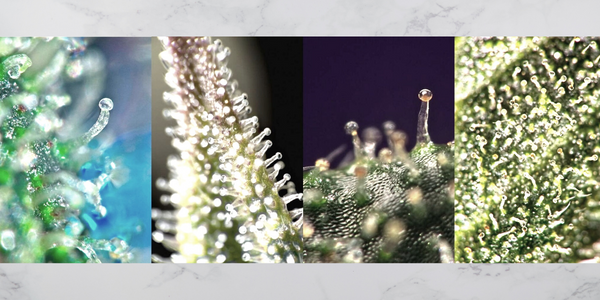
Clear trichomes
At this stage, the trichomes have only started appearing more prominently on your cannabis plants.
This means their THC is still forming, and your plants aren’t ready for harvest. However, seeing trichomes on your marijuana plants is a good sign of healthy growth.
One thing to take note of and something to add to your trichome harvest chart is that the density of your trichomes generally begins to increase once you make the switch from vegging to flowering.
If the number of trichomes on your plants has not increased after one week into flowering, it could be a sign of poor growing conditions.
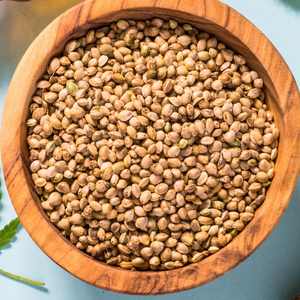
Fast growing marijuana seeds
- Easy to grow
- Guaranteed germination
- Grow guide available
- Beginner friendly
Cloudy / Milky trichomes
Once your trichomes have become cloudy, it’s a sign that the THC in them is reaching the ideal potency and flavor people want.
However, at this stage, the plant itself is not fully matured. That means the buds are small and don’t have the rich flavor and aroma most people want.
But, at this stage, the THC content in the trichomes is higher than its CBD, producing a more uplifting and energetic high.
Amber trichomes
You may notice that when you’re waiting for your trichomes to become milky, some of them will also become amber-colored.
This is because the process of trichomes turning amber happens at the same time when they start becoming milky.
If you choose to harvest your buds when most trichomes have become amber in color, they have a more pronounced sedative effect.
Mixed trichomes
Generally, many growers find that the best time to harvest their cannabis buds is when the trichomes are both milky and amber in color.
Many also suggest that the perfect ratio is 70% cloudy and 30% amber. This is because it offers the best mind and body high.
Trichomes harvest chart
When do trichomes usually appear on cannabis?
Unlike most of the development that occurs in cannabis, trichomes are not affected by genetics.
While its potency and flavor change depending on the strain, the time it takes for trichomes to start developing stays the same.
Because of this, it’s easy to tell when cannabis will start forming its trichomes.
Once your cannabis plants are in their third or fourth week of flowering, trichomes will start to appear on their leaves and buds.
And as a rule of thumb, you should begin feeding your flowering plants the necessary nutrients to improve trichome production.
If trichome density doesn’t increase during the third or fourth week of their flowering phase, it could be a sign of nutrient deficiency.
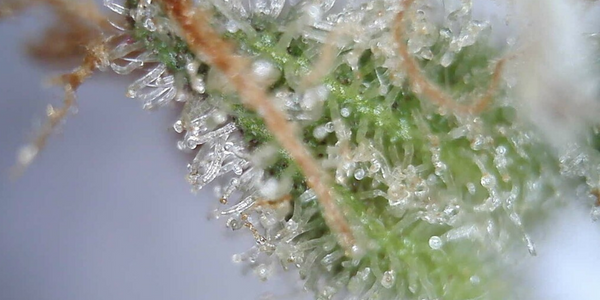
How to produce more trichomes on cannabis
Growers use many different ways to make their cannabis plants produce more trichomes.
One way to increase trichome density is using the best genetics. While the development of trichomes isn’t affected by a strain’s genetics, picking a strain known for its high trichome concentrations can guarantee plants with dense trichomes.
However, if you don’t have the ideal growing conditions, even the best strains won’t produce a lot of trichomes.
That’s why you need to use proper lighting. You would also need to feed your plants the required nutrients for improved trichome production.
Lastly, while this isn’t related to increased trichome production, stressing your plants can help improve the quality of your harvest.
By introducing hydric stress, you can increase the concentrations of cannabinoids in the trichomes of your plants.
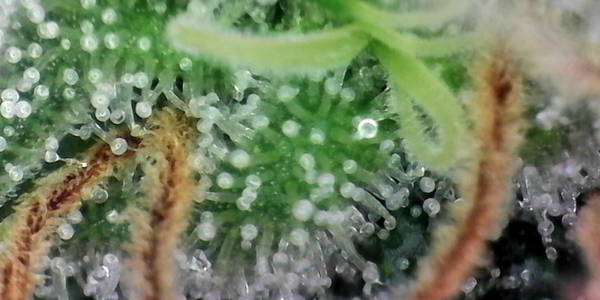
When should you harvest trichomes?
When growing weed, the most challenging part is waiting for your harvest to be ready.
Even once your buds have grown large and heavy, they still need time to ripen, which can be a problem for some growers.
In particular, outdoor growers must contend with seasonal changes and the immediate weather. This means, waiting for their buds to reach the ideal potency and flavor can be a huge risk to their harvest.
Indoor growers have it easier, but that’s not to say it’s free of any issues. Other than the electrical cost it would take to keep the lights on for their plants; there’s the potential for mold problems.
Download my free marijuana grow guide and start growing high quality marijuana strains.
Grow Bible

- Grow with my Quick Start Guide
- Discover secrets to Big Yields
- Avoid common grow mistakes
Error: Contact form not found.
Under the right circumstances, mildew may appear on the buds of their cannabis which can hurt the quality of their yield.
Fortunately, there are workarounds to these problems. For one, using fast-growing strains can help solve the issue of shifting seasons.
To prevent mold, maintain the ideal humidity and temperature for your cannabis as you wait for their buds to ripen.
With that said, at what stage of trichome development should you harvest your buds?
While it comes down to personal preference, the ideal stage should be when the trichomes on your buds are mostly cloudy as it has the most THC content.
Trichome chart for harvest
Photographing cannabis trichomes
For some growers, documenting the stages of their cannabis plants can mean complicated photography.
Pictures can be quite useful as they provide a reference for their next grow. In particular, pictures can help enhance your weed trichome chart.
By including week-by-week photos of your plants’ trichomes, you gain a reference point for how the trichomes should look week after week.
However, the problem with taking photographs of your trichomes is that they’re too small for your phone’s camera to properly capture.
You will need a professional camera with the right lens.
How to take pictures of cannabis trichomes? To take macro photos of your trichomes, you will need a camera with a macro lens.
The macro lens you’ll need should be high quality, perhaps on par with the Nikon AF-S Nikkor 85mm.
Outside of using the right lens, you also need to have the right type of light. For clear photos, use soft light.
If you use hard light, you will create overexposed parts and shadows on your plants.
The problem with getting the perfect lighting for your photos is that it may disturb your cannabis’ development.
Especially considering they’re in their flowering phase. The best solution is a speedlight that removes shadows from your photos without needing to adjust your grow lights.
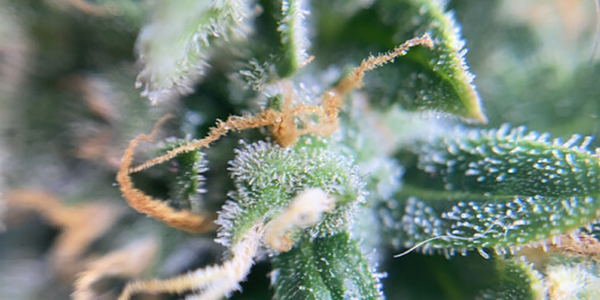
Conclusion
Trichomes are a vital part of a cannabis plant because it’s where cannabinoids and terpenes are produced and stored.
Without it, marijuana would lose its potency and distinct aroma and flavor. If you want a good harvest, you must exercise patience and wait for your buds to ripen.
You can have something to look forward to harvesting by growing the best genetics.
Purchase seeds at ILGM.com, where I carry a large selection of high-quality cannabis seeds.
Happy Growing,
Robert
FAQs about harvesting trichomes
Two main reasons can cause cannabis plants not to produce trichomes. The first is low-quality genetics. If you use bad seeds, it will yield bad plants that won’t produce the desired number of trichomes you want. The second is poor growing conditions. If the medium you’re using doesn’t supply your plants with the required nutrients, the trichomes on your buds won’t be as dense as you want them to be.
The best way to check trichome ripeness is by closely looking at them with a magnifying glass. Compare what you see to the stages on a cannabis trichome harvest chart.
There are different ways to determine when you should harvest your cannabis, all of which are covered in our harvest guide. But, the ideal way to get the most potent and flavorful yield is to harvest based on trichomes.
The post Trichome harvesting chart appeared first on I Love Growing Marijuana WRITTEN BY Robert Bergman.
